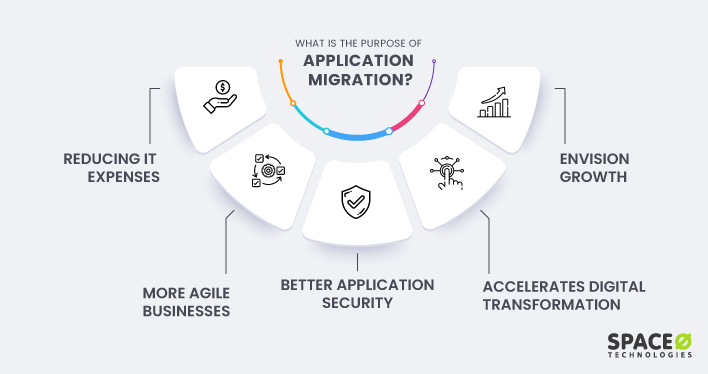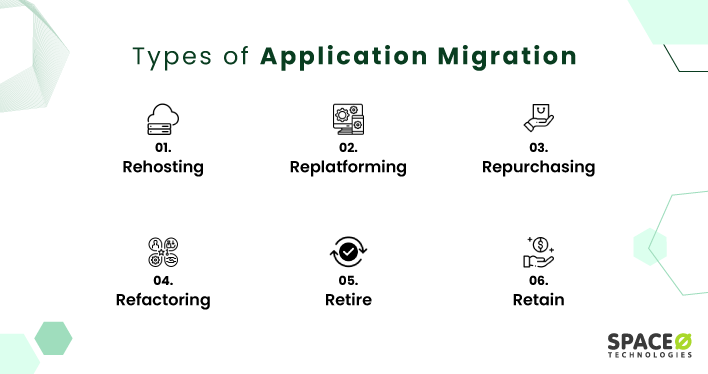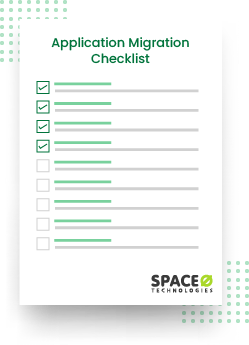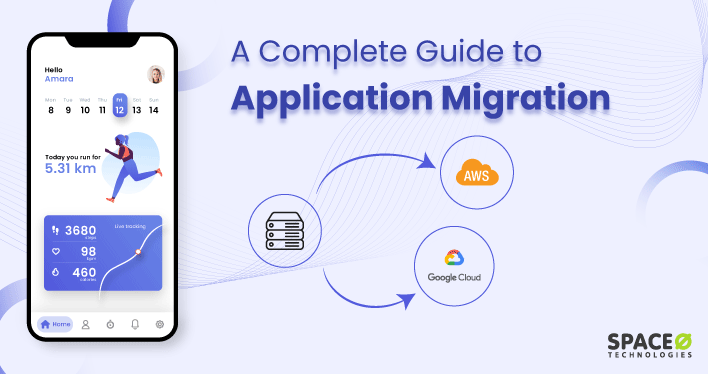- Want to reduce costs by moving your physical infrastructure to the cloud?
- Need to migrate your application to another platform due to performance and scalability issues?
- Want your team to focus on core tasks rather than maintaining hardware?
No matter whatever is the reason, an application migration will help you with seamless collaboration, scalability, and improved security.
Since we are a leading app development company in the USA, we understand what it takes to migrate an application. So, we have written this guide to provide you with an in-depth idea about application migration.
From this guide you will know:
- Meaning of an application migration
- Purpose of an application migration
- Required steps for an application Migration
- Types of an application migration
- Application migration checklist
Let’s get started.
Table of Contents
What Does an Application Migration Mean?
An Application migration is the process of moving your existing application from one computing environment (platform, datacenter, server, cloud) to another with minimal disruptions.
- From an on-premises data center to a cloud provider such as Azure, Google cloud platform, or AWS.
- From one cloud environment to another.
- From one data center to another.
- From the public cloud to private or hybrid cloud service
Common types of application migration includes migrating:
Now that we have understood the meaning of application migration, let’s understand why you should consider migrating your legacy application.
What is the Purpose of an Application Migration?

Migrating applications to different environments provides technology benefits like cost, speed, scalability, and flexibility. Here are the 6 purposes of an application migration for your business.
- Reduces IT Expenses and Prevents Overspending
When you adopt cloud migration services, you are reducing capital and maintenance costs. For example, if the particular data centre is expensive, you should consider legacy application migration to the cloud. You may experience unanticipated costs when you try to incorporate requirements for your business application. Similarly, you can look for data centres that are slightly inexpensive. By moving applications to the cloud, you pay for the services you acquire, reducing your spending.
- Provides Scalability When Your Business Grows
When you operate in one computing environment, the chances of scaling at demand are lower. You might not be able to access resources and infrastructure to meet the new demands. However, with cloud platforms, your business’ agility increases. You immediately get the competitive edge by matching footsteps with the changing business environment.
- Improves Your App’s Security Level
With an application migration, you can meet the security and compliance requirements of the software solution better. For instance, when you move to the cloud, you can access the tools to prevent hackers from entering your systems. You can model the governance and IT security practices for enterprise applications.
- Accelerates Digital Transformation to Increase Collaboration
When you move your software applications to the cloud infrastructure, you can add more value to your business assets by thriving on software solutions. For instance, cloud computing can help digitize business processes with SAP, ERP, CRM, and data analytics, all of which are easily accessible and collaborative in the cloud environments.
- Grows Your Business Faster
When you move your existing applications to a new cloud provider or cloud platform in specific, you can provide your enterprise with an organic expansion. You can easily add supporting technologies or new tools to enhance the software solution. It is easier to digitize business-critical processes, enhance legacy applications and scale your business towards growth. As you add new customers, you can enhance the channels to grow your business faster.
Looking to Migrate Your Application?
Get in touch with us. Book your 30-minute free consultation and validate your idea of app migration.

Let’s understand how to perform application migration.
Which are the Required Steps for an Application Migration?
It is important to have a defined strategy to move your application to the target environment. Let’s take a look at the step-by-step process for the same.
Determine the Goals of Migrating Your Application
To determine the migration plan, you need to identify the migration goals. Check why you need a migration. It will help identify the migration type and move in the right direction.
Goals could be improving cloud performance or enhancing operations. It could also be to cut down the costs. The goals will help in identifying the migration plan and path.
Audit Your Existing Applications
Before you move ahead with the application migration, you should check the existing systems and assess their worthiness. It would help you identify whether you want to retain, refactor or remove the system from existence. During the evaluation, you should check if the current system is usable. Think about the following question before you audit the application.
- Which is the type of app? Business app or technical app?
- Why does your app requires app migration?
- Will refactoring or rewriting be required?
- Was the app developed in-house or by a third party?
Determine if the system has been updated regularly and what software aspects require recoding/rewriting. Check if you need to update the operating systems to newer versions during the assessment.
Choose a Suitable Team for an Application Migration
Once you have audited your application, you need app development consulting company, to guide you with the application migration. Experienced app migration consultant validates your idea and suggest you the roadmap on how to proceed ahead.
Apart from this, you can outsource and hire dedicated app developers who have experience in app migration. that can help with successful cloud migration. When you hire dedicated developers, you eliminate the costs of hiring, training, and infrastructure. All you have to do it select the best developers, and get your application migration work done. Know how to hire app developers
Plan the Strategy for Migrating Your Application
During the application migration planning process, app developers will check the documentation created on the system evaluation. It will help if have written down the goals and teams. Experienced app migration consultants will dig out your technical requirements, analyze the feasibility, and check the migration tools for migrating your applications.
The app development company you have hired will define the phases for moving the application to newer systems with the right tools. App migration developers will move from the existing environment to the cloud with the help of these tools. Developers identify the tools needed for analytics and monitoring that can help you plan better.
Test the Strategy Created for App Migration
Before you move ahead with the actual migration process, the developer does a mock migration. This will helps to know if your devised strategy will work in your case. Build a sandbox environment that can help you test better.
When app migration developers conduct the migration directly in the actual environment, they may combat many issues requiring immediate attention. The sandbox environment allows to solve the issues and ensure your plan is ready for error-free migration. It can catch the issues early and change the data migration direction for better outcomes.
Migrating Apps in Phases
It is now time to migrate your apps to an alternate environment. App migration developers cannot complete the migration in a single go. Phases are defined that are iterative to conduct the complete migration. App migration developers can document every part of the migration carefully using relevant tools. The documentation can help the stakeholders stay in the loop and manage the migration.
Conduct Follow-up Tests After Completing Migration
Once the migration is completed, app migration developers conduct follow-up tests to know if the migration is successful. The tests check the application’s performance in the other environment. Similarly, you can check for disruptions in the application usability with these tests.
Developers can also check the database security in the new environment. For example, in the case of health insurance portability, developers conduct compliance monitoring to see if the data is fully migrated without any losses.
Let’s further understand different types of application migration in detail.
What are the Different Types of Application Migration?

Whether you want to access a third-party application or wish to replace on premise server with virtual machines, application migration can help. However, it is important you are aware of the application migration type that best fits your purpose.
Rehosting- Lift and Shift Application Migration
In this case, you are shifting to a hosting provider that suits your business needs. You will focus on cloud environments such as IaaS to enhance application performance. You could also move from a private cloud environment to a hybrid cloud with this migration type. You can easily migrate applications with minimal architecture and implementation concerns in this type.
Replatforming- Rip and Replace Program Migration
In this case, you are upgrading the applications to a better-performing platform. For example, moving an on-premise application to the public cloud could be attributed to re-platforming. In this case, you review the entire architecture and revamp the software structure to suit the cloud provider’s environment.
Repurchasing – Drop and Shop Application Migration
When you move your existing application to a SaaS platform, it is defined as repurchasing. In this case, the application is managed by a third-party application. When you move to SaaS, you don’t need resources to handle unexpected downtime and manage the network infrastructure. With this migration plan, you can define new pricing plans.
Refactoring – Rip and Replace Program Migration
You can consider applying this application migration type when you have reviewed the existing application and identified the new technical requirements. For example, moving from monolithic to virtual servers could be considered refactoring.
Retire – Drop and Shop Application Migration
In the case of highly regulated industries that thrive on sensitive data, this is an essential application migration type. It is important for these companies to audit the existing systems and identify the software solutions that are no longer useful. It is possible that these solutions are no longer suitable for cloud migration either. You can consider retiring them.
Retain – Keep and Consider Application Migration
It is important to retain only those on-premise solutions that can become cloud-native. You should consider the worthiness of the solutions, their ability to match your new needs and other aspects before considering retention.
Looking for an App Migration Company?
Contact us to migrate your app to a different environment or platform. We are a leading app development company in the USA has experienced in hassle-free app migration.
Let’s look at the complete application migration checklist you can use for successful cloud migration.
Application Migration Checklist to Follow
If you plan to route your applications to a new environment, you should consider using this application migration checklist to ensure you have completed all the steps.
Ask yourself these questions before you proceed with the process and checklist. It will help with the proper planning of the migration.
- Does your application need migration? Should you retain the application or remove it?
- How complex is the current application? Do you believe the migration will resolve the issues you are facing?
- Is it a legacy application? Will you face data losses in case of migration?
- Are there other applications dependent on this software solution?
- Does the application include mission-critical data that you cannot avoid during the migration?
- What is the downtime that you can handle?
- What are the standards for uptime you can follow? Do you have a service level agreement for the same?
- Who is managing the application?
- Are you currently handling the application with an on-premises server? Do the data centers offer the required security?
- Lastly, what is the project duration you are visualizing?
Once you have answered to these questions, download this sheet to get the complete checklist before performing application migration.
- No sign-in required
- Easy to customize

Let’s answer a few frequently asked questions about migration.
Frequently Asked Questions About an Application Migration
What is application migration to the cloud?
Application migration to the cloud involves shifting an existing on-premise application to the cloud infrastructure. Depending on the requirements, you can choose public cloud resources such as Google cloud or a private environment.
What does application migration do?
The experts move the existing applications to a newer environment in application migration projects. This could be another data center or an application environment, depending on the needs of the software solution.
Ready to Migrate Your Application to Another Environment?
Application migration can help you reduce operational costs and enhance the performance of the software solution. Choosing a suitable application migration strategy is important for moving the software to another environment.
From this guide, you know the step-by-step migration process and the different approaches to migration. You can download the migration checklist to determine if you are following the right path.
As a leading application migration company, SpaceO Technologies has the resources and defined strategies to accelerate migration. You can connect with our team if you want help with your application migration project.



